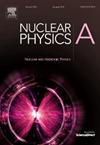12C(p, p′)12C反应测量12C霍伊尔态辐射衰减宽度
IF 2.5
4区 物理与天体物理
Q2 PHYSICS, NUCLEAR
引用次数: 0
摘要
Hoyle态是12C的第二激发态,激发能为7.65 MeV,在核合成中起着至关重要的作用。它的辐射衰减宽度是12C和宇宙中所有重元素形成的关键通道。为了研究这一点,我们进行了专门的实验,通过12C(p, p ')12C反应来测量霍伊尔态的辐射衰减宽度。辐射衰变分支比Γrad/Γ为4.03(21)× 10−4。根据目前公认的Γπ(E0)/Γ和Γπ(E0),计算出霍伊尔态的辐射宽度为3.75(40)× 10−3 eV。本文章由计算机程序翻译,如有差异,请以英文原文为准。
Measurement of radiative decay width of the Hoyle state of 12C via 12C(p, p′)12C reaction
The Hoyle state, the second excited state of 12C at an excitation energy of 7.65 MeV, plays a vital role in nucleosynthesis. Its radiative decay width serves as a crucial channel for the formation of 12C and all heavier elements in the Universe. To investigate this, exclusive experiments were conducted to measure the radiative decay width of the Hoyle state via the 12C(p, p′)12C reaction. The radiative decay branching ratio /Γ was determined to be 4.03(21) × 10−4. Based on the currently accepted values of and , the radiative width of the Hoyle state was calculated as 3.75(40) × 10−3 eV.
求助全文
通过发布文献求助,成功后即可免费获取论文全文。
去求助
来源期刊

Nuclear Physics A
物理-物理:核物理
CiteScore
3.60
自引率
7.10%
发文量
113
审稿时长
61 days
期刊介绍:
Nuclear Physics A focuses on the domain of nuclear and hadronic physics and includes the following subsections: Nuclear Structure and Dynamics; Intermediate and High Energy Heavy Ion Physics; Hadronic Physics; Electromagnetic and Weak Interactions; Nuclear Astrophysics. The emphasis is on original research papers. A number of carefully selected and reviewed conference proceedings are published as an integral part of the journal.
 求助内容:
求助内容: 应助结果提醒方式:
应助结果提醒方式:


